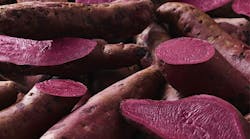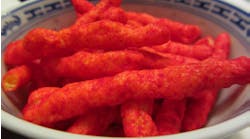What has a billion monthly users, has posted 50 billion photographs and fits in your pocket? The answer lies within your smart phone in an app called Instagram, part of the social media phenomenon feeding the push for natural colors. (By the way, did you know you can follow Food Processing on Instagram?)
Instagram might not be solely responsible for this push, but at least one market research firm, Innova Market Insights, claims natural colors are experiencing an “Instagrammable boom” as consumers embrace vibrant color and experiential eating and drinking.
Why natural colors in particular, though, and not the bright shades achievable through synthetics? This Instagram food trend, the report says, couples the practice of creating attractive images with lifestyle practices — a lifestyle that for millennials is about “authenticity, naturalness and esthetics.”
The hashtag #cleaneating is on trend and in line with clean label expectations that touch on every ingredient, including and especially color.
The International Food Information Council confirms this, stating consumers want to understand the origins of their food and its journey from “farm to fork.” This helps create an environment ripe for natural colors, with global corporations embracing this farm-to-fork mantra -- or, in the case of certain natural colors, a “seed to shelf” development process, as Sensient Food Colors calls it.
Firms like Sensient, Archer Daniels Midland and Chr. Hansen are investing in agronomy to help optimize pigmentation and performance of resources bred for natural colors.
"The whole color spectrum appears in fruit, vegetables or other natural sources," says a spokesperson for ADM, whose portfolio of colors came with its 2014 acquisition of Wild Flavors and Specialty Ingredients. The result is the Colors from Nature portfolio.
New micronized color powders from ADM are made of particles that are smaller than conventional color pigments, giving them a larger surface area and increasing their opacity. As a result, they give foods striking coloring. Raw materials include safflower, curcumin, red radish and spirulina.
Red 40 for example, is one of the most commonly used "artificial" food dyes in the U.S. For a while, carmine played a role as a suitable substitute in certain applications. However, while carmine isn’t a synthetic, since it is derived from the cochineal beetle, it also isn’t vegetarian, kosher or halal. And there's a "yuck" factor when consumers learn its origin.
One company might offer a red based on beets, another from carrot. In the case of Chr. Hansen, the company recently commercialized the Hansen Sweet Potato and found it is unique, due to its specific coloring properties. Dina Dix, applications manager in the Natural Colors Division at Chr. Hansen said the color it supplies is a bright, true “fire engine red,” creating a suitable plant-based substitute for carmine or Red 40.
Colors based on agronomy selection can take years to bring to market. Dix said this particular sweet potato’s commercialization as a color source was an almost decades-long process. Through selective breeding the company was able to increase the pigment strength within this sweet potato variety while supplying application stability.
While Chr. Hansen has developed its own sweet potato as a red coloring source, it also relies on beetroot for the color.
She said the company began by looking at different anthocyanin sources in the quest for a bright red, examining numerous plant-based sources such as black carrots, cabbages and elderberries. “We already had sweet potato in our portfolio but finding and cultivating this variety was the first challenge.”
Getting a natural red in the test tube is one thing. Maintaining that exact shade of red under varying processing conditions — that’s the challenge. “The unique thing about the Hansen Sweet Potato is we see less shade shift with it as pH increases.” Dix says red colors derived from black carrot, for instance, shift to more of a purple tone as the pH increases to 5 or 6.
Anthocyanins, the natural pigments present in fruits and vegetables and responsible for their bright hues, are extremely unstable in their native state. In addition to pH, their performance can be altered by factors such as chemical structure, temperature, light, oxygen, ascorbic acid, sulfur dioxide and metal ions. However, each type of natural color, depending on its original source, will react to different environments. Some are stable under heat treatment but react to light. Others might be stable under light but react to pH or water activity.
According to Dix, natural colors can be affected by other common ingredients. “Ascorbic acid might increase stability of carotenoids, for example, but in the case of an anthocyanin-based color, it could increase degradation.
“In addition, there are certain sources within the red fruit or vegetable juice categories that may fill the headspace in a container. And when a formulator tries to increase the dosage, off-flavors can be possible,” she continues. “This is not an issue with the Hansen Sweet Potato, which makes it more versatile.”
In general, vegetable-based anthocyanins provide greater stability than those that are fruit-based due to their molecular structure.
Chr. Hansen offers a broad, global portfolio of pigments along with a wide range in the U.S. based on anthocyanins, annatto, paprika, turmeric, beta-carotene and spirulina for blues and greens.
Spirulina presents formulators with a natural option but one that also can spark off flavors. According to Dix, “Off flavors can be dosage-dependent. In some products with a lower dosage you don’t notice it, but in products with a high dosage or high intensity it is more noticeable.”
And dosage becomes a more primary consideration in an era of unicorn foods or mermaid-inspired products. One special report issued by Innova states that children and adults respond differently to colors. Children and, surprisingly, senior citizens prefer stronger, monochromatic colors. A brightly colored monochromatic product will attract a child’s interest and in colors not necessarily attractive to adults, such as blue ice cream.
It appears far less challenging to introduce a new product using natural colors than it is to shift colors in an iconic brand. “Those iconic brands are the most difficult and often the most risky for the manufacturer,” says Dix. Natural colors can provide a match, but “some shades are easier than others and application dependent.”
That was the case with Trix. General Mills replaced the synthetic ingredients in the colorful breakfast cereal in late 2015, with colorants from turmeric, strawberries, radishes and purple carrots. But the cereal lost its famous neon colors, and the blue and green pieces had to go because the company couldn't find natural replacements.
Less than two years later, the synthetic colors (and some flavors) were back. "We heard from many Trix fans that they missed the bright vibrant colors and the nostalgic taste of the classic Trix cereal," a spokesperson explained in 2017.
Bright yellow might be possible, but neon or day-glo oranges and greens might not be. Surprisingly, Dix said that there have been occasions formulating a new product when the natural color match is brighter than the artificial option. Companies in that case might ask them to tone the colors down for fear their customer base might assume the bright hue comes from artificial colorants


